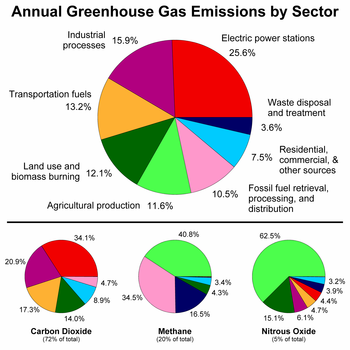Greenhouse gases and their sources
Carbon dioxide is undoubtedly, the most important greenhouse gas in the atmosphere. Changes in land use pattern, deforestation, land clearing, agriculture, and other activities have all led to a rise in the emission of carbon dioxide.
Methane is another important greenhouse gas in the atmosphere. About ¼ of all methane emissions are said to come from domesticated animals such as dairy cows, goats, pigs, buffaloes, camels, horses, and sheep. These animals produce methane during the cud-chewing process. Methane is also released from rice or paddy fields that are flooded during the sowing and maturing periods. When soil is covered with water it becomes anaerobic or lacking in oxygen. Under such conditions, methane-producing bacteria and other organisms decompose organic matter in the soil to form methane. Nearly 90% of the paddy-growing area in the world is found in Asia, as rice is the staple food there. China and India, between them, have 80-90% of the world's rice-growing areas.
Methane is also emitted from landfills and other waste dumps. If the waste is put into an incinerator or burnt in the open, carbon dioxide is emitted. Methane is also emitted during the process of oil drilling, coal mining and also from leaking gas pipelines (due to accidents and poor maintenance of sites).
A large amount of nitrous oxide emission has been attributed to fertilizer application. This in turn depends on the type of fertilizer that is used, how and when it is used and the methods of tilling that are followed. Contributions are also made by leguminous plants, such as beans and pulses that add nitrogen to the soil.
Carbon dioxide is undoubtedly, the most important greenhouse gas in the atmosphere. Changes in land use pattern, deforestation, land clearing, agriculture, and other activities have all led to a rise in the emission of carbon dioxide.
Methane is another important greenhouse gas in the atmosphere. About ¼ of all methane emissions are said to come from domesticated animals such as dairy cows, goats, pigs, buffaloes, camels, horses, and sheep. These animals produce methane during the cud-chewing process. Methane is also released from rice or paddy fields that are flooded during the sowing and maturing periods. When soil is covered with water it becomes anaerobic or lacking in oxygen. Under such conditions, methane-producing bacteria and other organisms decompose organic matter in the soil to form methane. Nearly 90% of the paddy-growing area in the world is found in Asia, as rice is the staple food there. China and India, between them, have 80-90% of the world's rice-growing areas.
Methane is also emitted from landfills and other waste dumps. If the waste is put into an incinerator or burnt in the open, carbon dioxide is emitted. Methane is also emitted during the process of oil drilling, coal mining and also from leaking gas pipelines (due to accidents and poor maintenance of sites).
A large amount of nitrous oxide emission has been attributed to fertilizer application. This in turn depends on the type of fertilizer that is used, how and when it is used and the methods of tilling that are followed. Contributions are also made by leguminous plants, such as beans and pulses that add nitrogen to the soil.


